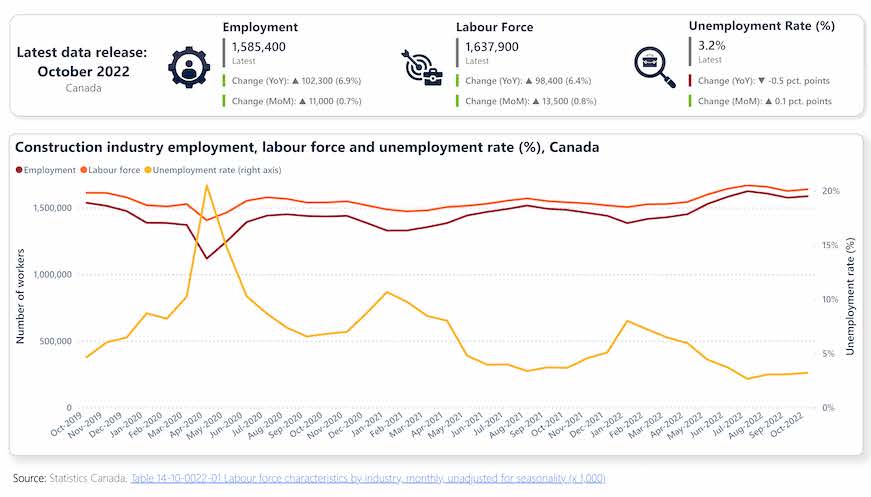The latest Labour Force Survey (LFS) published by Statistics Canada shows a broad but modest increase in employment across the country in October. Statistics Canada collected its LFS data during the week of October 9 to 15.
Seasonally adjusted data shows an increase in employment of 108,000 (+0.6%). The increase—which was widespread across industries, including manufacturing, construction, and accommodation and food services—brought employment back to a level on par with the most recent peak observed in May 2022.
Statistics Canada attributes the increase in employment to a number of factors, including an increasing trend of immigrants and permanent residents in finding employment and filling job vacancies. LFS data shows that, at 62.2%, the employment rate of immigrants aged 15 and older was at its highest-ever October level. Additionally, at 70.7%, the employment rate among those people who were admitted to Canada within the last five years was 5.6 percentage points higher than in October 2019.
Meanwhile, the national, all-industry unemployment rate held steady at 5.2% in October. That figure is 0.3 percentage points above the record low of 4.9% reported in June and July and is a clear indicator that labour markets across the country and in nearly all industries remain constrained.
Construction labour markets remain constrained
Construction continues to grapple with its own labour force challenges, even as the calendar turns to the fourth quarter of the year, when workloads conventionally slow. Indeed, the latest building permit data reported by Statistics Canada, for September, shows a drop in the value of building permits of 22% compared to the previous month.
Construction employment increased by 11,000 (0.7%) to 1.585 million in October, while the labour force added 13,600 workers (0.8%) to reach nearly 1.64 million. Nationally, industry employment increased 6.9% over October 2021.

Across the country, six provinces reported increases in employment in October over the previous month. Prince Edward Island at 10% reported the largest relative gain in employment, followed by Quebec (4.1%), and Saskatchewan and Nova Scotia (both at 2.3%). Quebec also reported the largest absolute gain in employment, adding 12,000 jobs for the month. Newfoundland and Labrador (-3.9%) reported the largest percentage drop in employment in October while Ontario shed the greatest number of jobs at -7,500.
Year-over-year, employment grew in seven provinces, with only Saskatchewan (-2.6%), Newfoundland and Labrador (-2.5%), and Manitoba (-0.2%) reporting contractions. Growth was strongest in Nova Scotia (24.6%), Prince Edward Island (20.3%) and British Columbia (10.9%).
October marks the third month in a row in which construction’s unemployment rate has increased. The rate grew from 3.1% in September to 3.2% in October. Even taking the increase into account, labour markets remain historically constrained. The national unemployment rate remains below 2021’s low of 3.7% and well below the five-year average of 4.6% for October.
Five provinces reported unemployment rates below the national figure in October: Manitoba (3.1%), Ontario (2.7%), Quebec (2.4%), British Columbia (2.1%) and Prince Edward Island (1.3%). Newfoundland and Labrador (15.1%), New Brunswick (7.8%), and Saskatchewan (5.7%) all reported rates above the national figure.
Finally, job vacancies in the construction sector continue to remain about the 82,000-mark. Across all sectors of the economy, employers were looking to fill a combined 958,500 jobs at the end of August.


Construction Key Indicators
